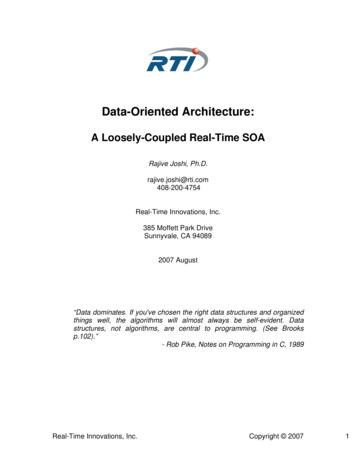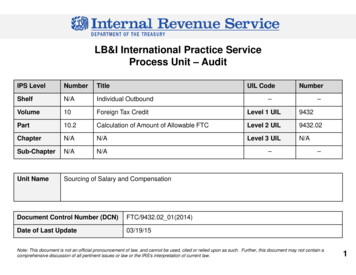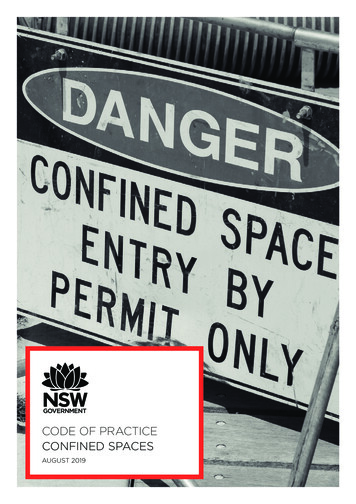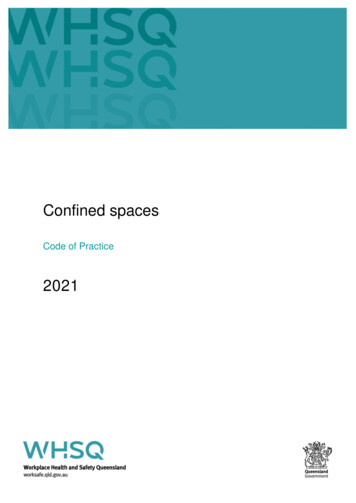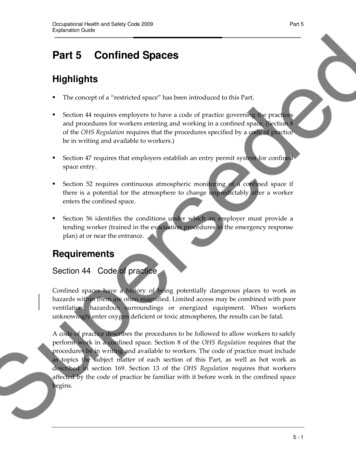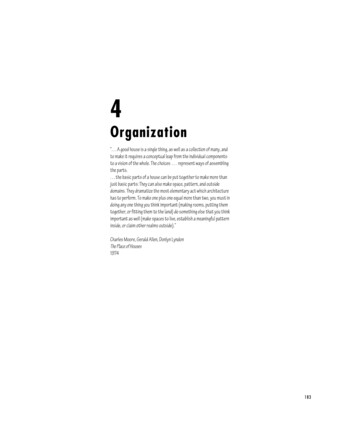
Transcription
4Organization“. . . A good house is a single thing, as well as a collection of many, andto make it requires a conceptual leap from the individual componentsto a vision of the whole. The choices represent ways of assemblingthe parts. . . the basic parts of a house can be put together to make more thanjust basic parts: They can also make space, pattern, and outsidedomains. They dramatize the most elementary act which architecturehas to perform. To make one plus one equal more than two, you must indoing any one thing you think important (making rooms, putting themtogether, or fitting them to the land) do something else that you thinkimportant as well (make spaces to live, establish a meaningful patterninside, or claim other realms outside).”Charles Moore, Gerald Allen, Donlyn LyndonThe Place of Houses1974183
O R G ANIZATIO N O F FO RM A N D SPA C EThe last chapter laid out how various configurations of form could be manipulated to define a solitary field orvolume of space, and how their patterns of solids and voids affected the visual qualities of the defined space.Few buildings, however, consist of a solitary space. They are normally composed of a number of spaces whichare related to one another by function, proximity, or a path of movement. This chapter lays out for study anddiscussion the basic ways the spaces of a building can be related to one another and organized into coherentpatterns of form and space.Alhambra, Palace and Citadel of the Moorish kings,Granada, Spain, 1248–1354184 / A R C H I TE C TU R E : F O R M , S PA C E , & O R D E R
S PAT I A L RE L AT I ON S H I P STwo spaces may be related to each other in several fundamental ways.Space within a SpaceA space may be contained within the volumeof a larger space.Interlocking SpacesThe field of a space may overlap the volume ofanother space.Adjacent SpacesTwo spaces may abut each other or share acommon border.Spaces Linked by a Common SpaceTwo spaces may rely on an intermediaryspace for their relationship.ORGANIZATION / 1 8 5
SPACE WITH IN A SPACEA large space can envelop and contain a smaller spacewithin its volume. Visual and spatial continuity betweenthe two spaces can be easily accommodated, butthe smaller, contained space depends on the larger,enveloping space for its relationship to the exteriorenvironment.In this type of spatial relationship, the larger, envelopingspace serves as a three-dimensional field for the smallerspace contained within it. For this concept to be perceived, a clear differentiation in size is necessary betweenthe two spaces. If the contained space were to increasein size, the larger space would begin to lose its impact asan enveloping form. If the contained space continued togrow, the residual space around it would become too compressed to serve as an enveloping space. It would becomeinstead merely a thin layer or skin around the containedspace. The original notion would be destroyed.To endow itself with a higher attention-value, thecontained space may share the form of the envelopingshape, but be oriented in a different manner. This wouldcreate a secondary grid and a set of dynamic, residualspaces within the larger space.The contained space may also differ in form from theenveloping space in order to strengthen its image as afreestanding volume. This contrast in form may indicatea functional difference between the two spaces or thesymbolic importance of the contained space.186 / A R C H I TE C TU R E : F O R M , S PA C E , & O R D E R
S PA C E W I T H I N A S PA C EMoore House, Orinda, California, 1961, Charles MooreGlass House, New Canaan, Connecticut, 1949, Philip JohnsonORGANIZATION / 1 8 7
INTE R L O CKING SPACESAn interlocking spatial relationship results from theoverlapping of two spatial fields and the emergence ofa zone of shared space. When two spaces interlocktheir volumes in this manner, each retains itsidentity and definition as a space. But the resultingconfiguration of the two interlocking spaces is subjectto a number of interpretations.The interlocking portion of the two volumes canbe shared equally by each space.The interlocking portion can merge with one of thespaces and become an integral part of its volume.The interlocking portion can develop its own integrityas a space that serves to link the two original spaces.188 / A R C H I TE C TU R E : F O R M , S PA C E , & O R D E R
I N T E RL OC K I N G S PA C E SPlan for St. Peter (Second Version), Rome, 1506–1520,Donato Bramante & Baldassare PeruzziPilgrimage Church, Vierzehnheiligen,Germany, 1744–72, Balthasar NeumannVilla at Carthage, Tunisia, 1928, Le CorbusierThe one-story space flows into the larger volume ofwhich it is a part and to the outdoors.ORGANIZATION / 1 8 9
AD J ACE NT SPACESAdjacency is the most common type of spatial relationship. It allows each space to be clearly defined and torespond, each in its own way, to specific functional orsymbolic requirements. The degree of visual and spatialcontinuity that occurs between two adjacent spacesdepends on the nature of the plane that both separatesand binds them together.The separating plane may: limit visual and physical access between two adjacentspaces, reinforce the individuality of each space, andaccommodate their differences. appear as a freestanding plane in a single volumeof space. be defined with a row of columns that allows a highdegree of visual and spatial continuity between the twospaces. be merely implied with a change in level or a contrast insurface material or texture between the two spaces.This and the preceding two cases can also be readas single volumes of space which are divided into tworelated zones.190 / A R C H I TE C TU R E : F O R M , S PA C E , & O R D E R
A DJ A C E N T S PA C E SPavilion Design, 17th century, Fischer von ErlachUpper LevelThe spaces in these two buildings are individualistic in size,shape, and form. The walls that enclose them adapt their formsto accommodate the differences between adjacent spaces.Main LevelThree spaces—the living, fireplace, and dining areas—are defined bychanges in floor level, ceiling height, and quality of light and view, ratherthan by wall planes.Lower LevelChiswick House, Chiswick, England, 1729, Lord Burlington & William KentLawrence House, Sea Ranch, California, 1966, Moore-Turnbull/MLTWORGANIZATION / 1 9 1
SPACE S LINKED BY A CO MMO N SPA C ETwo spaces that are separated by distance can be linkedor related to each other by a third, intermediate, space.The visual and spatial relationship between the two spacesdepends on the nature of the third space with which theyshare a common bond.The intermediate space can differ in form and orientationfrom the two spaces to express its linking function.The two spaces, as well as the intermediate space, canbe equivalent in size and shape and form a linear sequenceof spaces.The intermediate space can itself become linear in form tolink two spaces that are distant from each other, or join awhole series of spaces that have no direct relationship toone another.The intermediate space can, if large enough, becomethe dominant space in the relationship, and be capable oforganizing a number of spaces about itself.The form of the intermediate space can be residualin nature and be determined solely by the forms andorientations of the two spaces being linked.192 / A R C H I TE C TU R E : F O R M , S PA C E , & O R D E R
S PA C ES LIN K E D B Y A C OM M ON S PA C EPalazzo Piccolomini, Pienza, Italy, c. 1460,Bernardo RosselinoCaplin House, Venice, California, 1979, Frederick FisherOne-half House (Project), 1966, John HejdukORGANIZATION / 1 9 3
SPATIAL O RGANIZATIO NSCompositions of Nine Squares:A Bauhaus StudyThe following section lays out the basic ways we can arrange and organize thespaces of a building. In a typical building program, there are usually requirementsfor various kinds of spaces. There may be requirements for spaces that: have specific functions or require specific forms are flexible in use and can be freely manipulated are singular and unique in their function or significance to thebuilding organization have similar functions and can be grouped into a functional clusteror repeated in a linear sequence require exterior exposure for light, ventilation, outlook, or accessto outdoor spaces must be segregated for privacy must be easily accessible194 / A R C H I TE C TU R E : F O R M , S PA C E , & O R D E RThe manner in which these spaces are arranged can clarify their relativeimportance and functional or symbolic role in the organization of a building.The decision as to what type of organization to use in a specific situationwill depend on: demands of the building program, such as functional proximities,dimensional requirements, hierarchical classification of spaces, andrequirements for access, light, or view exterior conditions of the site that might limit the organization’s formor growth, or that might encourage the organization to address certainfeatures of its site and turn away from others
S PAT I A L ORG A N I Z AT I ON SEach type of spatial organization is introduced by a section that discussesthe formal characteristics, spatial relationships, and contextual responses ofthe category. A range of examples then illustrates the basic points made in theintroduction. Each of the examples should be studied in terms of: What kinds of spaces are accommodated and where? How are they defined? What kinds of relationships are established among the spaces, one toanother, and to the exterior environment? Where can the organization be entered and what configuration does thepath of circulation have? What is the exterior form of the organization and how might it respond toits context?Centralized OrganizationA central, dominant space about which a number of secondaryspaces are groupedLinear OrganizationA linear sequence of repetitive spacesRadial OrganizationA central space from which linear organizations of spaceextend in a radial mannerClustered OrganizationSpaces grouped by proximity or the sharing of a common visualtrait or relationshipGrid OrganizationSpaces organized within the field of a structural grid or otherthree-dimensional frameworkORGANIZATION / 1 9 5
CE NTR ALIZED O RGANIZAT IO N SA centralized organization is a stable,concentrated composition that consistsof a number of secondary spaces groupedaround a large, dominant, central space.The central, unifying space of theorganization is generally regular in form andlarge enough in size to gather a number ofsecondary spaces about its perimeter.The secondary spaces of the organizationmay be equivalent to one another in function, form, and size, and create an overallconfiguration that is geometrically regularand symmetrical about two or more axes.Ideal Church by Leonardo Da VinciSan Lorenzo Maggiore, Milan, Italy,c. A.D. 480196 / A R C H I TE C TU R E : F O R M , S PA C E , & O R D E RThe secondary spaces may differ from oneanother in form or size in order to respondto individual requirements of function,express their relative importance, oracknowledge their surroundings. This differentiation among the secondary spacesalso allows the form of a centralized organization to respond to the environmentalconditions of its site.
C E N T RA L I Z E D ORG A N I Z AT I ON SSince the form of a centralized organization is inherentlynon-directional, conditions of approach and entry mustbe specified by the site and the articulation of one of thesecondary spaces as an entrance or gateway.The pattern of circulation and movement within acentralized organization may be radial, loop, or spiralin form. In almost every case, however, the pattern willterminate in or around the central space.Centralized organizations whose forms are relativelycompact and geometrically regular can be used to: establish points or places in space terminate axial conditions serve as an object-form within a defined fieldor volume of spaceThe central organizing space may be eitheran interior or an exterior space.ORGANIZATION / 1 9 7
CE NTR ALIZED O RGANIZAT IO N SThese drawings are based on Leonardo da Vinci’s sketches of idealchurch plans. c. 1490198 / A R C H I TE C TU R E : F O R M , S PA C E , & O R D E R
C E N T RA L I Z E D ORG A N I Z AT I ON SCentralized Plans, 1547, Sebastiano SerlioS. Ivo della Sapienze, Rome, 1642–50, Francesco BorrominiORGANIZATION / 1 9 9
CE NTR ALIZED O RGANIZAT IO N SPlan for St. Peter’s (First Version), Rome, c. 1503, Donato BramantePalazzo Farnese, Caprarola, 1547–49, Giacomo da Vignola200 / A R C H I TE C TU R E : F O R M , S PA C E , & O R D E R
C E N T RA L I Z E D ORG A N I Z AT I ON STaj Mahal, Agra, India, 1632–54Humayun's Tomb, Delhi, India, 1565Villa Capra (The Rotunda), Vicenza, Italy, 1552–67, Andrea PalladioORGANIZATION / 2 0 1
CE NTR ALIZED O RGANIZAT IO N SThe Pantheon, Rome, A.D. 120–24. Portico from temple of 25 B.C.202 / A R C H I TE C TU R E : F O R M , S PA C E , & O R D E RHagia Sophia, Constantinople (Istanbul), A.D. 532–37,Anthemius of Tralles and Isidorus of Miletus
C E N T RA L I Z E D ORG A N I Z AT I ON SSan Lorenzo Maggiore, Milan, Italy, c. A.D. 480SS. Sergio and Bacchus, Constantinople (Istanbul), Turkey,A.D. 525–30ORGANIZATION / 2 0 3
CE NTR ALIZED O RGANIZAT IO N SStockholm Public Library, 1920–28, Gunnar Asplund204 / A R C H I TE C TU R E : F O R M , S PA C E , & O R D E RGuggenheim Museum, New York City, 1943–59, Frank Lloyd Wright
C E N T RA L I Z E D ORG A N I Z AT I ON SNational Assembly Building, Capitol Complex at Dacca, Bangladesh,begun 1962, Louis KahnGreenhouse House, Connecticut, 1973–75, John M. JohansenORGANIZATION / 2 0 5
L INE AR O RGANIZATIO NSA linear organization consists essentially of a seriesof spaces. These spaces can either be directly relatedto one another or be linked through a separate anddistinct linear space.A linear organization usually consists of repetitivespaces which are alike in size, form, and function. Itmay also consist of a single linear space that organizesalong its length a series of spaces that differ in size,form, or function. In both cases, each space along thesequence has an exterior exposure.Spaces that are functionally or symbolically importantto the organization can occur anywhere along thelinear sequence and have their importance articulatedby their size and form. Their significance can also beemphasized by their location: at the end of the linear sequence offset from the linear organization at pivotal points of a segmented linear formBecause of their characteristic length, linearorganizations express a direction and signify movement, extension, and growth. To limit their growth,linear organizations can be terminated by a dominantspace or form, by an elaborate or articulated entrance,or by merging with another building form or thetopography of its site.206 / A R C H I TE C TU R E : F O R M , S PA C E , & O R D E R
LI N E A R ORG A N I Z AT I ON SThe form of a linear organization is inherently flexibleand can respond readily to various conditions ofits site. It can adapt to changes in topography,maneuver around a body of water or a stand of trees,or turn to orient spaces to capture sunlight andviews. It can be straight, segmented, or curvilinear.It can run horizontally across its site, diagonally up aslope, or stand vertically as a tower.The form of a linear organization can relate to otherforms in its context by: linking and organizing them along its length serving as a wall or barrier to separate theminto different fields surrounding and enclosing them within a fieldof spaceCurved and segmented forms of linear organizationsenclose a field of exterior space on their concavesides and orient their spaces toward the center ofthe field. On their concave sides, these forms appearto front space and exclude it from their fields.ORGANIZATION / 2 0 7
L INE AR O RGANIZATIO NSLonghouse, a dwelling type of the member tribes of the Iroquois Confederacy in North America, c. 1600.Terraced Housing Fronting a Village Street, Village Project, 1955, James Stirling (Team X)208 / A R C H I TE C TU R E : F O R M , S PA C E , & O R D E R
LI N E A R ORG A N I Z AT I ON SResidential Expansion, St. Andrews University, Scotland, 1964–68, James StirlingLinear sequences of spacesTypical Apartment Floor, Unité d’Habitation, Marseilles, 1946–52, Le CorbusierSecond Floor Plan, Main Building, Sheffield University, England, 1953, James StirlingORGANIZATION / 2 0 9
L INE AR O RGANIZATIO NSLord Derby’s House, London, 1777,Robert AdamPearson House (Project), 1957,Robert VenturiLinear sequences of rooms Lloyd Lewis House, Libertyville, Illinois,1940, Frank Lloyd Wright210 / A R C H I TE C TU R E : F O R M , S PA C E , & O R D E R
LI N E A R ORG A N I Z AT I ON SRomano House, Kentfield, California, 1970, Esherick Homsey Dodge & Davisadapting to function and siteMarcus House (Project), Dallas, Texas, 1935, Frank Lloyd WrightORGANIZATION / 2 1 1
L INE AR O RGANIZATIO NSTown Center for Castrop-Rauxel, Germany, (Competition Entry), 1965,Alvar AaltoIntroducing hierarchy to linear sequences Interama, Project for an Inter-American Community, Florida, 1964–67,Louis Kahn212 / A R C H I TE C TU R E : F O R M , S PA C E , & O R D E R
LI N E A R ORG A N I Z AT I ON SBridge House (Project), Christopher Owenand expressing movementHouse 10 (Project), 1966, John HejdukORGANIZATION / 2 1 3
L INE AR O RGANIZATIO NSScarborough College,Westhill, Ontario, 1964,John AndrewsHousing Development, Pavia, Italy, 1966, Alvar AaltoLinear organizations adapting to site 214 / A R C H I TE C TU R E : F O R M , S PA C E , & O R D E R
LI N E A R ORG A N I Z AT I ON STypical Upper-floor Plan, Baker House, Massachusetts Institute of Technology,Cambridge, Massachusetts, 1948, Alvar AaltoPlan for the the Circus (1754, John Wood, Sr.) and the Royal Crescent (1767–75, John Wood) at Bath, Englandand shaping exterior spaceORGANIZATION / 2 1 5
R AD IAL O RGANIZATIO NSA radial organization of space combines elements of bothcentralized and linear organizations. It consists of a dominantcentral space from which a number of linear organizationsextend in a radial manner. Whereas a centralized organizationis an introverted scheme that focuses inward on its centralspace, a radial organization is an extroverted plan thatreaches out to its context. With its linear arms, it can extendand attach itself to specific elements or features of its site.As with centralized organizations, the central space of aradial organization is generally regular in form. The linear arms,for which the central space is the hub, may be similar to oneanother in form and length and maintain the regularity of theorganization’s overall form.The radiating arms may also differ from one another in orderto respond to individual requirements of function and context.A specific variation of a radial organization is the pinwheelpattern wherein the linear arms of the organization extendfrom the sides of a square or rectangular central space.This arrangement results in a dynamic pattern that visuallysuggests a rotational movement about the central space.216 / A R C H I TE C TU R E : F O R M , S PA C E , & O R D E R
RA DI A L ORG A N I Z AT I ON SMoabit Prison, Berlin, 1869–79, August Busse and Heinrich HerrmannHôtel Dieu (Hospital), 1774, Antoine PetitMaison de Force (Prison), Ackerghem near Ghent, Belgium, 1772–75,Malfaison and KluchmanORGANIZATION / 2 1 7
R AD IAL O RGANIZATIO NSHerbert F. Johnson House (Wingspread), Wind Point, Wisconsin, 1937, Frank Lloyd Wright218 / A R C H I TE C TU R E : F O R M , S PA C E , & O R D E R
RA DI A L ORG A N I Z AT I ON SKaufmann Desert House, Palm Springs, California, 1946, Richard NeutraORGANIZATION / 2 1 9
R AD IAL O RGANIZATIO NSSecretariat Building, UNESCO Headquarters, Place de Fontenoy, Paris,1953–58, Marcel BreuerSite PlanTypical Unit PlanResidential Expansion, St. Andrews University, Scotland, 1964–68, James Stirling220 / A R C H I TE C TU R E : F O R M , S PA C E , & O R D E R
RA DI A L ORG A N I Z AT I ON SGuggenheim Museum, Bilbao, Spain, 1991–7, Frank GehryNew Mummers Theater, Oklahoma City, Oklahoma, 1970, John M. JohansenPlan for Canberra, Australia, 1911, Walter Burley GriffinORGANIZATION / 2 2 1
CL U STE RED O RGANIZATIO NSRepetitive spacesSharing a commonshapeOrganized by an axisClustered about an entryGrouped along a pathA loop pathCentralized patternClustered patternContained within a spaceA clustered organization relies on physical proximityto relate its spaces to one another. It often consistsof repetitive, cellular spaces that have similarfunctions and share a common visual trait such asshape or orientation. A clustered organization canalso accept within its composition spaces that aredissimilar in size, form, and function, but related toone another by proximity or a visual ordering devicesuch as symmetry or an axis. Because its patterndoes not originate from a rigid geometrical concept,the form of a clustered organization is flexible andcan accept growth and change readily withoutaffecting its character.Clustered spaces can be organized about a point ofentry into a building or along the path of movementthrough it. The spaces can also be clustered about alarge defined field or volume of space. This pattern issimilar to that of a centralized organization, butit lacks the latter’s compactness and geometricalregularity. The spaces of a clustered organizationcan also be contained within a defined field or volumeof space.Since there is no inherent place of importancewithin the pattern of a clustered organization, thesignificance of a space must be articulated by itssize, form, or orientation within the pattern.Symmetry or an axial condition can be used tostrengthen and unify portions of a clusteredorganization and help articulate the importance ofa space or group of spaces within the organization.Axial conditionsAxial condition222 / A R C H I TE C TU R E : F O R M , S PA C E , & O R D E RSymmetrical condition
C LUS T E RE D ORG A N I Z AT I ON SFatehpur Sikri, Palace Complex of Akbar the Great Mogul Emperor of India, 1569–74ORGANIZATION / 2 2 3
CL U STE RED O RGANIZATIO NSSectionSpaces organized by geometryPlanOblique viewYeni-Kaplica (Thermal Bath), Bursa,TurkeyNuraghe at Palmavera, Sardinia, typical of the ancient stone towersof the Nuraghic culture, 18th–16th century B.C.Traditional Japanese House224 / A R C H I TE C TU R E : F O R M , S PA C E , & O R D E R
C LUS T E RE D ORG A N I Z AT I ON SMeeting House, Salk Institute of BiologicalStudies (Project), La Jolla, California, 1959–65,Louis KahnSpaces organized around a dominant spaceKaruizawa House, Country Retreat, 1974,Kisho KurokawaPalace of King Minos, Knossos, Crete, c. 1500 B.C.ORGANIZATION / 2 2 5
CL U STE RED O RGANIZATIO NSVadakkunnathan Temple, Trichur, India, 11th centuryRajarajeshwara Temple, Thanjavur, India, 11th centuryHouse for Mrs. Robert Venturi, Chestnut Hill, Pennsylvania, 1962–64, Venturi and ShortSpaces organized within a spatial field226 / A R C H I TE C TU R E : F O R M , S PA C E , & O R D E R
C LUS T E RE D ORG A N I Z AT I ON SSoane House, London, England, 1812–34, Sir John SoaneS. Carlo alle Quattro Fontane, Rome, 1633–41,Francesco BorrominiBank of England, London, England, 1788–1833, Sir John SoaneSpaces organized by axial symmetriesORGANIZATION / 2 2 7
CL U STE RED O RGANIZATIO NSMercer's Castle (Fonthill), Doylestown, Pennsylvania, 1908–10, Henry MercerFriedman House, Pleasantville, N.Y., 1950, Frank Lloyd WrightWyntoon, Country Estate for the Hearst Family in northern California,1903, Bernard Maybeck228 / A R C H I TE C TU R E : F O R M , S PA C E , & O R D E RSpaces organized by site conditions
C LUS T E RE D ORG A N I Z AT I ON SFallingwater (Kaufmann House), near Ohiopyle, Pennsylvania ,1936–37, Frank Lloyd WrightMorris House (Project), Mount Kisco, New York,1958, Louis KahnSpaces organized by geometric patternGamble House, Pasadena, California, 1908, Greene & GreeneORGANIZATION / 2 2 9
G R ID O RGANIZATIO NSA grid organization consists of forms and spaceswhose positions in space and relationships with oneanother are regulated by a three-dimensional gridpattern or field.A grid is created by two, usually perpendicular,sets of parallel lines that establish a regularpattern of points at their intersections. Projectedinto the third dimension, the grid pattern istransformed into a set of repetitive, modular unitsof space.The organizing power of a grid results from theregularity and continuity of its pattern thatpervades the elements it organizes. Its patternestablishes a stable set or field of reference pointsand lines in space with which the spaces of a gridorganization, although dissimilar in size, form, orfunction, can share a common relationship.230 / A R C H I TE C TU R E : F O R M , S PA C E , & O R D E R
G RI D ORG A N I Z AT I ON SA grid is established in architecture most often by askeletal structural system of columns and beams. Withinthe field of this grid, spaces can occur as isolated eventsor as repetitions of the grid module. Regardless of theirdisposition within the field, these spaces, if seen as positiveforms, will create a second set of negative spaces.Since a three-dimensional grid consists of repetitive,modular units of space, it can be subtracted from, addedto, or layered, and still maintain its identity as a grid withthe ability to organize spaces. These formal manipulationscan be used to adapt a grid form to its site, to define anentrance or outdoor space, or to allow for its growth andexpansion.To accommodate the specific dimensional requirements ofits spaces or to articulate zones of space for circulationor service, a grid can be made irregular in one or twodirections. This dimensional transformation would createa hierarchical set of modules differentiated by size,proportion, and location.A grid can also undergo other transformations. Portions ofthe grid can slide to alter the visual and spatial continuityacross its field. A grid pattern can be interrupted to definea major space or accommodate a natural feature of its site.A portion of the grid can be dislocated and rotated abouta point in the basic pattern. Across its field, a grid cantransform its image from a pattern of points to lines, toplanes, and finally, to volumes.ORGANIZATION / 2 3 1
G R ID O RGANIZATIO NSCity of Priene, Turkey, founded 334 B.C.Plan of Dura-Europos, near Salhiyé, Syria, 4th century B.C.Mosque of Tinmal, Morocco, 1153–54232 / A R C H I TE C TU R E : F O R M , S PA C E , & O R D E R
G RI D ORG A N I Z AT I ON SCrystal Palace, London, England, Great Exhibition of 1851, Sir Joseph PaxtonIIT Library Building, Chicago, Illinois, 1942–3, Ludwig Mies van der RoheBusiness Men’s Assurance Co. of America, Kansas City,Missouri, 1963, SOMORGANIZATION / 2 3 3
G R ID O RGANIZATIO NSHospital Project, Venice, 1964–66, Le CorbusierCentraal Beheer Office Building, Apeldoorn, The Netherlands,1972, Herman Hertzberger with Lucas & Niemeyer234 / A R C H I TE C TU R E : F O R M , S PA C E , & O R D E RAdler House (Project), Philadelphia, Pennsylvania, 1954, Louis Kahn
G RI D ORG A N I Z AT I ON S4321GShodhan House, Ahmedabad, India, 1956, Le CorbusierORGANIZATION / 2 3 5
G R ID O RGANIZATIO NSGandhi Ashram Museum, Ahmedabad, India, 1958–63, Charles CorreaSnyderman House, Fort Wayne, Indiana, 1972, Michael GravesManabe Residence, Tezukayama, Osaka, Japan, 1976–77, Tadao Ando236 / A R C H I TE C TU R E : F O R M , S PA C E , & O R D E R
G RI D ORG A N I Z AT I ON SEric Boissonas House I, New Canaan, Connecticut, 1956, Philip JohnsonKimball Art Museum, Forth Worth, Texas, 1967–72, Louis KahnORGANIZATION / 2 3 7
Abu Simbel, Great Temple of Rameses II, 1301–1235 B.C.
depends on the nature of the third space with which they share a common bond. The intermediate space can differ in form and orientation from the two spaces to express its linking function. The two spaces, as well as the intermediate space, can . Architecture:

